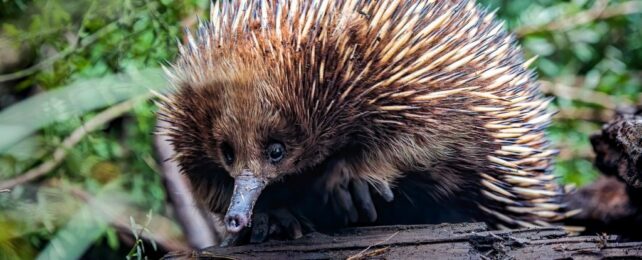 The short-beaked echidna (Tachyglossus aculeatus) is an obligate myrmecophage. (tracielouise/iStock/Getty Images Plus)
The short-beaked echidna (Tachyglossus aculeatus) is an obligate myrmecophage. (tracielouise/iStock/Getty Images Plus)
If you want to get by in this world, you could do a lot worse than developing a predilection for ants. In fact, ant-eating may be a dramatically overlooked recipe for success.
According to new research, relying on ants as a sole food source has evolved at least 12 times in mammals since the reign of the dinosaurs ended some 66 million years ago. But it's not the ant-exclusive diet itself that is the wonder: it's that it always follows a similar blueprint.
"It's not necessarily surprising that mammals would specialize on ant-eating, as ecological niches almost inevitably get filled," biologist Thomas Vida of the University of Bonn in Germany told ScienceAlert, "but rather that we see the same, or at least very similar, morphological adaptations across so many unrelated groups."
It's one of the most striking examples of convergent evolution, in which dramatically different organisms can come to evolve similar features to solve similar problems.
Related: Evolution Keeps Making Crabs, And Nobody Knows Why

There are a lot of ants on planet Earth. A recent study estimated the number of individual ants at around 20 quadrillion, for a combined biomass of 12 megatons of dry carbon. That's more than all the wild mammals and birds combined, and around 20 percent of the human biomass.
It wasn't always this way; just after the dinosaurs went extinct, ants represented less than 1 percent of the insect population, exploding around 23 million years ago at the beginning of the Miocene.
Many animals happily include insects as part of their diet, including mammals. It makes sense: insects are plentiful, and full of nutrition. However, a diet that revolves exclusively around ants – a strategy called obligate myrmecophagy – is a little more rare.
"One of the things my lab focuses on is how social insects like ants and termites have reshaped the history of life on the planet," entomologist Phillip Barden of the New Jersey Institute of Technology told ScienceAlert.
"Ants in particular have altered the trajectory of evolution in lots of insect and plant lineages, but a lingering question that I've had is just how much mammals have had to reckon with the rapid ascent of ants and termites over the last 100 million years. I also just love giant anteaters."

To investigate, Vida, Barden, and their colleague Zachary Calamari of City University of New York undertook a painstaking review of more than 600 published scientific sources to compile a database of the dietary habits of 4,099 mammal species.
The researchers divided these animals into five different categories based on their diets: insectivores, carnivores, omnivores, herbivores, and the obligate myrmecophages. These were then mapped onto an animal family tree to observe how these dietary adaptations emerged over tens of millions of years.
Myrmecophagy, the researchers found, emerged at least 12 times, with 2 more tentative instances that could not be confirmed. This includes animals such as anteaters, pangolins, echidnas, numbats, and aardvarks – a diversity that the researchers did not expect – across all three major mammal groups: placental mammals, marsupials, and monotremes.
These animals all developed similar traits to optimize eating ants.
"There are a few obvious things: their skulls and tongues tend to elongate, their teeth often get reduced, and they usually have strong claws/forelimbs for tearing into insect nests," Vida explained.
"There are also some less obvious things, like their low body temperatures/slow metabolisms and their enzymatic adaptations towards digesting chitin, both of which are adaptations for surviving off of abundant, but low-energy food."

The finding is reminiscent of the famous phenomenon whereby crab body plans keep emerging, with at least five separate crab evolutions throughout evolutionary history. Well, crabs are cool and all, but apparently ants are where the real party is at.
Related: Parasites May Be Hijacking Evolution on Planet Earth
"Ants really seem to be engineers of convergent evolution," Barden said.
"There are twice as many origins of ant- and termite-eating in mammals as there are origins of crab body plans. And that's not even counting the over 10,000 species of arthropods that mimic ant and termite morphology, behavior, or chemical signaling to evade predation or get access to social insect resources."
Their work, the researchers say, lays a solid foundation for future studies of mammalian dietary strategies. Vida notes that their database will allow further investigations of fascinating dietary specializations, and to drill down into the origins of individual myrmecophagous species. There may even be some interesting discoveries waiting in comparative studies of insectivorous birds, reptiles, and amphibians.
"The history of life is full of crossovers. Even very distantly related lineages – social insects and mammals last shared a common ancestor more than 500 million years ago – interact in ways that can kick off striking specializations over tens of millions of years," Barden said.
"As we rapidly reshape our planet, it's important to remember that the loss of any one species may have lots of unexpected consequences."
The research has been published in Evolution.

.jpg) 4 hours ago
1
4 hours ago
1
 English (US)
English (US)